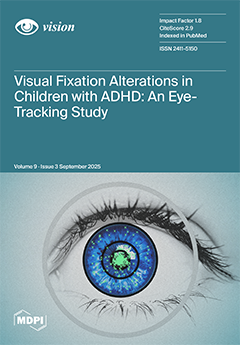Background: Congenital insensitivity to pain with anhidrosis (CIPA) is a rare autosomal recessive syndrome caused by loss-of-function mutations in the Neurotrophic Tyrosine Kinase Receptor 1 gene, characterized by recurrent episodes of infections and unexplained fever, anhidrosis, absence of reactions to noxious stimuli,
[...] Read more.
Background: Congenital insensitivity to pain with anhidrosis (CIPA) is a rare autosomal recessive syndrome caused by loss-of-function mutations in the Neurotrophic Tyrosine Kinase Receptor 1 gene, characterized by recurrent episodes of infections and unexplained fever, anhidrosis, absence of reactions to noxious stimuli, intellectual disability, self-mutilating behaviors, and damage to many body organs, including the eyes.
Main text: We systematically searched the Medline/PubMed, Scopus, and Web of Science databases from their inception until March 2025 for papers describing the clinical manifestations of patients with CIPA. The inclusion criterion was papers reporting ocular manifestations of patients diagnosed with CIPA. We excluded non-English papers or those reporting ocular manifestations of patients diagnosed with syndromes other than CIPA. Also, we excluded review articles, clinical trials, gray literature, or any paper that did not report ocular manifestations of patients with CIPA or that reported patients with previous ocular surgeries. Out of 6243 studies, 28 were included in the final analysis, comprising 118 patients. The mean age was 7.37 years, and males represented 63.5% (n = 75). Of the patients, fifty-six had bilateral ocular manifestations. The most common ocular manifestations were the absence of corneal reflex in 56 patients (47.5%, bilateral in 56), whereas corneal ulcerations were the second most common manifestation in 46 patients (38.98%, bilateral in 8), followed by corneal opacity in 32 patients (27.11%, bilateral in 19). Topical lubricants, topical antibiotics, and lateral tarsorrhaphy were common management modalities for these patients. Absent corneal sensitivity, corneal ulcers, and corneal opacities, among other manifestations, are common ocular presentations in patients with CIPA.
Conclusions: Self-mutilation, intellectual disability, decreased lacrimation, and absence of the corneal reflex are factors that may explain the development of these manifestations in CIPA. The early detection of these manifestations can improve patient conditions and prevent further complications, in addition to helping to guide the clinical diagnosis of CIPA in these patients.
Full article






